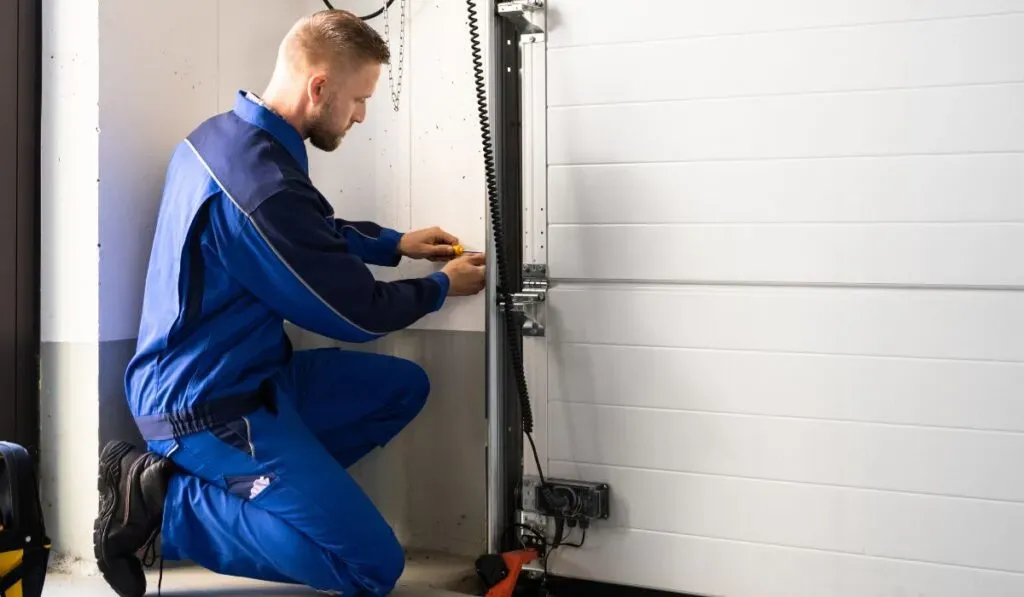
It help prevent sensor misalignment caused by electronic eyes affected by sun glare, ensuring smooth garage door operation. Simple steps like cleaning lenses, checking wiring, adjusting sensor position, and using snap-on shades or pipe caps can reduce interference and blinking LED codes effectively.
How Sunlight Affects Garage Door Sensors – An Overview
Sunlight can mess up garage door sensors. When direct sunlight hits them, it causes sunlight interference. This makes the sensor confused and sometimes stops it from working right.
The strong light can overload the sensor’s infrared signals. Environmental factors like bright daylight make the sensor fail to spot obstacles correctly. Knowing this helps you keep your garage door working smoothly.
Garage Door Sensors – Types and How They Work
Garage doors usually have two kinds of sensors: infrared photo sensors and obstacle detection sensors. These sensors send out an invisible infrared beam across the door’s path. If something blocks the beam, the door won’t close to avoid accidents. But bright sun or glare can cause problems. This is called infrared sensor blockage, which makes the sensors think something is there even when it isn’t.
Why Sunlight Interferes with Electronic Eyes: Infrared Overload
Sunlight confuses electronic eyes because of infrared overload. When strong sunlight shines straight on a sensor, it tricks the device into thinking there’s an object blocking its path. That causes wrong signals, like blinking lights or refusing to close. This happens because sunlight has lots of infrared light that floods the sensor.
Symptoms of Sun Interference – Recognizing the Signs
Look out for these signs if your sensor is getting hit by sun glare:
- Sensor blinking red
- Erratic blinking that doesn’t make sense
- Lights flashing when nothing’s in front of them
- The garage door refuses to close
Identifying the Problem – Is It Really Sun Glare?
Sunlight interference happens when sun rays hit garage door sensors just right. This mostly occurs in south-facing garages like ones in Newport Coast. It causes false signals or blocks sensors, called electronic eye sun glare. Here’s what to look for:
- Sensors work fine early in the morning but fail at mid-day.
- Sensor LEDs blink weird only during bright sun hours.
- Garage door reverses even when nothing blocks it.
Figuring this out stops you from fixing the wrong problem and helps focus on reducing daylight glare interference.
Adjusting Sensor Height for Optimal Performance

The height you install your garage door sensors matters a lot.
- Most pros say 6 inches above the ground is best.
- This stops little stuff like dirt or small pets from setting it off but still catches kids or animals near the door.
- If your sensor is too high or low, adjust it by moving the mounting brackets till it hits that spot.
Check sensor height now and then to keep things safe and working well.
Sensor Shielding – Blocking the Sun’s Rays
Sunlight can mess with garage door sensors. When direct light hits those infrared beams, they can act funny or fail.
You can block sun rays with these:
- Snap-on shades made just for garage door sensors
- Pipe cap shields built from pieces of PVC pipe around the sensors
- Cardboard tubes as quick covers during bright sunny times
These blockers stop harsh sun but still let beams do their job. It cuts down on sensor mistakes caused by glare.
When to Call 24/7 Garage Door Repair for Alignment Issues
Sometimes your fixes won’t cut it, especially if wiring or parts get damaged badly causing frequent problems no matter what you try.
Call pros when you see:
- Persistent blinking LEDs despite cleaning and adjusting can indicate a need for professional garage door sensor repair in Newport Beach.
- Sensors acting up only in certain light conditions still after shielding efforts
- Mounts or wiring looking broken needing new parts
Technicians run full checks and fix issues fast any time day or night—making sure your garage door works safe all year long.
Monthly Maintenance Checks – Keeping Your Sensors Aligned
Doing regular checks keeps sensors working well and stops glitches caused by dirt or misalignment.
Do these every month:
- Wipe sensor lenses gently with a soft cloth; dust can block beams and cause errors.
- Make sure sensors face each other straight without tilting.
- Look over wiring for any loose or worn spots that could break signals.
- Watch how your door closes at different daylight times to catch issues early.
Performing regular garage door maintenance in Newport Beach, including monthly sensor checks, helps ensure optimal performance even as daylight conditions change with the support of garage door maintenance in Newport Beach.
Seasonal Planning – Anticipating Sun Angle Changes
Sun moves across the sky differently depending on season. This changes how much glare hits your garage door sensors during the day.
Keep in mind:
- Early mornings in spring and fall bring more glare on east-side sensors; add shields before sunrise light hits them hard.
- Afternoon sun shines stronger on west-facing garages in summer—extra shading helps then.
Planning for these shifts stops surprising problems with solar interference messing up your garage door system.
